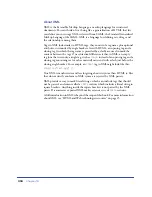
407
17
CHAPTER 17
. . . . . . . . . . . . . . . . . . . . . . . . . . . . . . . . . . . . . . . . . . . . . . . . . . . . . . . .
. . . . . . . . . . . . . . . . . . . . . . . . . . . . . . . . . . . . . . . . . . . . . . . . . . . . .
Using Dynamic Layers
A layer is a container in your Web page that holds HTML page elements. Using
layers in your page gives you more control and flexibility to make your page
dynamic. Layers were created for use in Web design to give designers the same
kind of control and flexibility that they have in traditional print design.
You can stack one layer on top of another, hide some layers while showing others,
or move a layer across the screen with a timeline. For example, you could have a
background image on one layer, then stack another layer on top that holds text.
You could also have images on your page that appear and then fade off the page.
All of this can be done using layers in Macromedia Dreamweaver, without having
to do any JavaScript or HTML coding.
A disadvantage to using layers in your Web page is that layers are not widely
viewable in older Web browsers. Only Internet Explorer 4.0 and Netscape 4.0 and
above browsers show layers, and not always consistently. In order for everyone to
be able to view your Web page, you can use layers in conjunction with tables. You
can design your page layout using layers, then convert the layers to tables. For
more information, see “Using tables and layers for layout” on page 421.
Note:
It is recommended that you use Layout view for page layout (See “Designing Page
Layout” on page 167). Layout view is an easier way to implement your page layout with
tables as the underlying structure.
Summary of Contents for 38028779 - Macromedia Dreamweaver - Mac
Page 1: ...macromedia Using Dreamweaver...
Page 148: ...Chapter 4 148...
Page 296: ...Chapter 12 296...
Page 472: ...Chapter 18 472...
Page 512: ...Chapter 21 512...
Page 562: ...Appendix 562...
















































